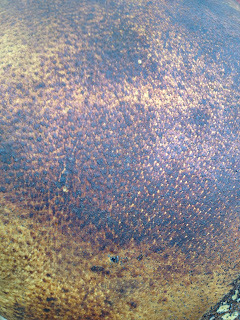I can't really say if this is THE Russian way, but it's the way that the three Russians wanted to do it when they bought a pig today.
What we usually do when scraping a pig this size is to boil 30 gallons of water, and then use a bucket to ladle the water onto the pig, scraping the hair off as we go. These guys didn't want to use the water method, asking if they could use the propane torch we use to heat the water.
"ok, you go to youtube, and you search 'ukrainian pig scraping', and you see what to do". Wait a second -- I thought you said you were from Russia -- so you're Ukrainian? "No, no, he is from Ukraine, I am from Belarus, former soviet union". Ok. So you're Belarusian? "No, when you are 16 they ask you what you are, and he and I speak Russian, so we said we were Russian, but I could have said Ukrainian or whatever". Ok. So where you're from is whatever you said when you were 16? "yes, in the past, now is countries. "
They'd burn the hair off, and then the skin would blacken, and they'd keep going until it was pretty black, and then lay a wet towel over it, and scrape off all of the singed area.
After they'd scraped it, they blackened the whole pig again and scraped it again. The end result was a pig that was kind of yellow colored and hair-free. The hot water method results in a white pig.
With the skin charred, a hot towel was applied and then the char was scrubbed off.
We gave them the standard cake spatulas we use.
"Can we use that?" pointing to my hay barn. No, you can't use that, this is where we process the pigs. "no, the, how you say it... the grass, in the barn" the hay? the bales of hay? "yes! yes! we light fire with hay, and it burns, and I like the taste of the meat when it is that way" So you burn off the hair with burning hay? "yes, you break the bundle and put it on the pig" using hands he makes a pyramid, showing the hay stacked on the pig. "high, like this!, and then burn it, and it is tradition!"
Sure, if you want to do that, I'll sell you a bale for $6. "Ok! maybe next time! "
Took about 2 hours for them to get the pig into the shape that they were happy with, about the same amount of time for a boiled-water scald.
Kinda fun to learn about the customs and traditions. These guys had watched as children as their parents processed pigs, and missed it. This was their re-connection to their roots.
(note: We put the pig on pallets to allow the water to drain as it was scrubbed, and to keep the concrete from cracking from the heat of the torch. )









Did they eat the skin after they cooked the hog?
ReplyDeleteDid they roast the hog or roast it whole?
Most of the time when people take the trouble to scrape a hog they do so because they want to eat the skin, or to use the parts of the animal with the skin attached. Think proscuitto, or instance, which requires skin-on hams.
ReplyDeleteThese guys would cut a little bit off the ears and chew it as they worked. The skin is delicious; In the southern part of the us, pork rinds, or cracklings, are prized and devoured.
A good way is to scald the pig whole. We do this in an old bath tub, (a heavy cast iron/steel tub), out in the paddock. Fill it just over half full with clean water and light a fire with wood placed on the ground all around the tub. When it boils, dunk the pig for a few minutes and check if the bristles will scrape off easily, if not dunk again until they do. Then remove and continue scraping. Wash down and dry on completion. You should have a nice clean pink/white pig at the end, with skin good enough for perfect crackling.
ReplyDeleteThis assumes that you start with a white pig. If the pig is black or black/brown/white blotched etc, don't expect such good results. Commercially pigs here are worth a lot less if they have coloured or blotched skin. Consumers expect pork to be white/pink and the coloured ones are skinned and processed into small goods.
Wild pigs which are rarely nice and pink and have very dirty skin are always hard to process into nice good looking meat. Most of us no longer bother to do this, and simply skin them without any scraping. If you want crackling when roasting, simply buy nice clean pig skin and fat from your butcher and lay that on top od your wild pork roast.
Burning off the bristles will work but the skin is generally not fit to eat afterwards and always has a burnt taste. With wild pigs it is traditional to light a big fire and using two people throw the pig into the ashes.flames until the bristles burn off. This results in a bristle-less pig with ashes and dirt well burnt into the skin. Tastes awful and is usually discarded after roasting. Some use a gas torch burner, (paint burner), and burn and scrape much like your Russians bur this doesn't remove the dirt very well and it always taints the shin with a foul burnt taste. Do a web search for "pig scrapers" or "hog scrapers" to see some easily made scraping tools. The "bell" scraper is the most modern version I think.